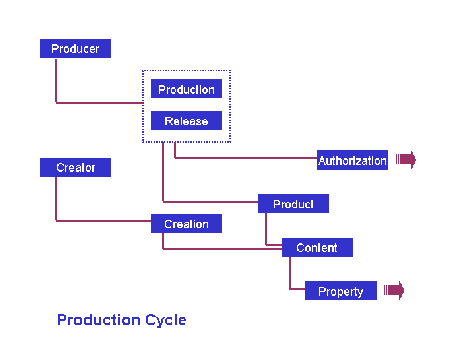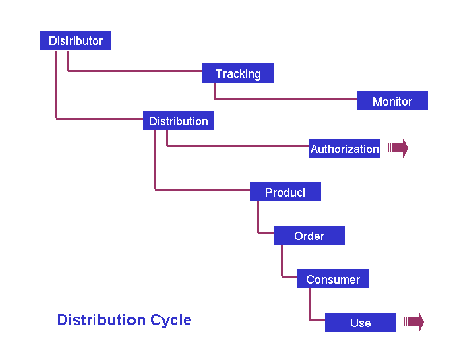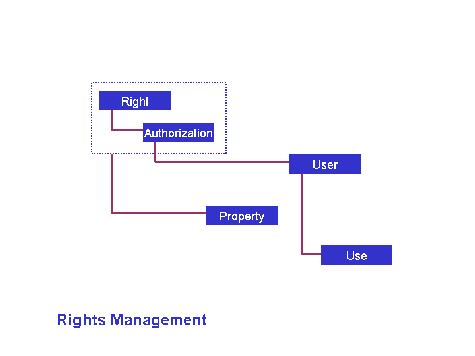|
About The Forum
Program
Speakers
Registration
Hotel and Travel
Contact Us
Sponsorship Opportunities
Sponsors
Webcast
Committee
Presentation Abstracts
Speaker Biographies
2005 Forum
|
|
Canadian <Metadata> Forum
Content Delivery and Rights Management
Identifiers and Descriptive Metadata
in a Multimedia Context
Tom Delsey
Consultant, Ottawa, Ont.
| © Tom Delsey. Reproduced with the permission of Tom Delsey. |
Available also in [PDF 191 KB] (slides) and [PDF 187 KB] (with comments)
Introduction
-
Asked to address issue of cross-domain interoperability
-
Presentation based on work done for a group of organizations representing various interests within the "content" industries - publishing, music, sound recording, film and video industries
-
Sponsoring organizations are responsible for managing identifier systems (ISBN, ISSN, etc.) developed within Technical Committee 46, Subcommittee 9 of the International Organization for Standardization (ISO). TC46/SC9 is hosted at the Library and Archives of Canada
-
Focus on the role of identifiers and descriptive metadata in supporting network transactions associated with content delivery and rights management in a multimedia, cross-sector environment
-
Highlight some conclusions drawn from the project that are relevant to the broader issue of developing metadata schemes to support interoperability
Context
-
new business models
-
cross-sector transactions
-
standard identifiers
-
descriptive metadata
New business models:
-
content industries beginning to explore new business models
-
driven by the introduction of new digital technologies that support integration of media and delivery of products and services through open multimedia networks
-
new competitive environment - new players, strategic repositioning
-
industries rethinking traditional “stove pipe” approach to business
Cross-sector transactions:
-
strategic positioning requires exploitation of technical potential for cross-sector transactions
-
emergence of technical infrastructure to support e-commerce
-
framework for global multimedia infrastructure being developed by MPEG (formerly the Moving Picture Expert Group), a joint standards committee of ISO and the IEC (International Electrotechnical Commission)
Standard identifiers:
-
organizations responsible for the development and assignment of standard identifiers recognize the potential role to be played by identifiers in supporting content delivery and rights management in this new environment
-
need for refinement and extension of identifier schemes
Descriptive metadata:
-
need to develop schema for descriptive metadata to support user transactions associated with resource discovery and control of resource use
Objectives
-
shared frame of reference for describing business and information transactions
-
structured statement of requirements to guide further development of standards
Shared frame of reference:
-
establish a common perspective on the overall business context within which identifiers and descriptive metadata function
-
clarify understanding of the kinds of information transactions involved in content delivery and rights management
Structured statement of requirements:
-
development of a conceptual business architecture and information model
-
systematic analysis of metadata requirements in relation to user transactions
Business architecture
-
identify functions performed by individuals and organizations
-
highlight key business relationships
Purpose:
-
identify functions performed by individuals and organizations involved in the production and distribution of intellectual and artistic content and the management of rights associated with that content
-
highlight key business relationships that operate between those functions
Content Delivery and Rights Management

Two major areas of activity: content delivery and rights management
Key functions within the two areas:
-
at one end, origination of content and ownership of rights in that content; at the other end, the consumption of content
-
in between the two ends on the content delivery side: key functions in the supply chain - production and delivery of content
-
in between on the rights management side: administration of rights
-
straddling the two broad areas of activity: network support functions - registration of content, rights, and products; monitoring the distribution and use of content; certifying or authenticating distributors and users
Business relationships between functions:
-
transfer of rights between originators and subsequent owners or licensees
-
transfer of content through the supply chain (from originator to producer to distributor to consumer)
-
administration of rights-related transactions with owners, producers, distributors, and consumers
-
registration of content by originators; registration of rights by owners; registration of products by producers
-
monitoring distribution and reporting transactions to rights administrators
-
certifying distributors for administrators and consumers; authenticating users for distributors and rights administrators
Diverse range of functions; multiplicity of interconnected business relationships
Information architecture
- structured representation of key entities and relationships
-
objects, agents, activities, events, etc.
- three business functions
-
production
-
distribution
-
rights management
Structured representation of key entities and relationships:
-
developed entity-relationship model to reflect key objects, agents, activities, events, etc. that are the focus for identifiers and descriptive metadata
Three business functions:
- model comprises three segments representing the content production and distribution cycles and the rights management function
Production Cycle

Production cycle:
-
central object: product (analog/digital: book, sound recording, video, etc.)
-
key events: production and release of product
-
associated agent: producer
-
subsidiary object: content incorporated in product (e.g., tracks of music on a sound recording)
-
key event: creation of content
-
associated agent: creator (writer, composer, artist, etc.)
-
key object from rights management perspective: property embodied in content (e.g., work, performance, recording embodied in track)
-
key event: authorization for production and release of content (i.e., property embodied in content)
Distribution Cycle

Distribution cycle:
-
key object: product
-
key event: distribution of product
-
associated agent: distributor
-
secondary object: order placed for product
-
associated agent: consumer
-
secondary event associated with distributor: tracking of distribution and reporting to monitoring service
-
key entities from rights management perspective: authorization for distribution of product by distributor and its use by consumer
Rights Management

Rights management:
-
key object: property (work, performance, recording, etc.)
-
associated entities: rights and authorizations attached to the property
-
key events from rights management perspective: granting of authorization to the user, and use of the property by the user
Information model as a whole reflects diverse range of entities and complex interrelationships between those entities
Significant degree of overlap in the entities and relationships that are relevant to each of the business functions
User transactions
- Resource discovery
-
search / identify / select
- Resource access
- Resource use
Defined a set of generic user transactions supported by identifiers and descriptive metadata
Transactions associated with resource discovery:
-
search (for a product, content, etc.)
-
identify (property, distributor, etc.)
-
select (i.e., choose product, content, etc. appropriate to user needs)
Transactions associated with resource access:
-
access (i.e., access physically or through online connection)
-
acquire (i.e., purchase, license, etc.)
Transactions associated with resource use:
-
open (i.e., open file or digital object using software application)
-
use (i.e., reproduce, record, communicate, adapt, etc.)
-
control (i.e., control access and use)
Mapping Attributes
Table 5.1 : Attributes and Relationships of Content Mapping to User Transactions

Mapping attributes to user transactions:
-
identified key attributes of each of the entities defined in the information model
-
mapped attributes of primary entities (product, content, property) to the eight user transactions
-
identified types of identifiers and descriptive metadata required to support each type of transaction
-
basis for developing a metadata set for the various identifier schemes (ISBN, ISSN, ISAN, ISWC, ISTC, ISRC)
Interoperability
- functional perspective
-
product / content / property
- granularity
-
aggregate / unit / component
- identity
-
recognition of change / modification
Key challenges for developing interoperable metadata schemes
Diversity of functional perspectives:
-
perspective on object being identified/described affected by the functional context within which the identification and descriptive processes are designed
-
producer views product as key object; originator/user views content as key object; rights owner/administrator views property as key object
-
need to be clear on what class of object is being identified/described and how the objects in different classes are related
Functional granularity:
-
business transactions deal with objects at different levels of aggregation
-
product may be marketed as a single unit or as an aggregate of units
-
content may be searched/accessed as a unit or as a component of a unit
-
granularity of identification/description driven by functional requirements of users (producers, distributors, consumers, rights administrators)
What constitutes identity:
-
application of identifier schemes dependent on perception of what is being identified
-
objects that are subject to modification or extension are problematic
-
need to establish functional criteria for recognizing a new object (and assigning a new identifier and appropriate descriptors)
-
recognition of new identity subject to differences in functional perspective
|




